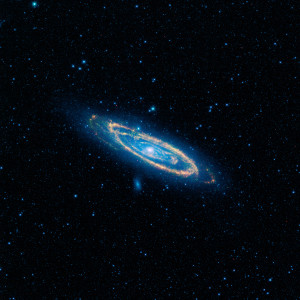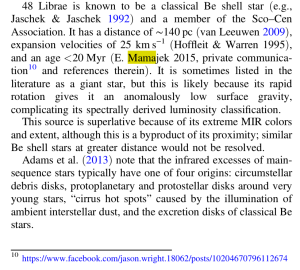Last time, I described our work on red spirals. That’s it for the big results in our paper (*whew*!).
So what’s next?
Well, this was a pilot program, to see what was feasible, what a waste heat search is up against. There are a few future directions to take:
- We can try to distinguish natural emission from alien waste heat. There are many ways to do this. Two of them, broadly:
-

The Great Galaxy in Andromeda, as seen by WISE. The red, MIR emission is clearly coming from dust in the spiral arms, not the smooth distribution of stars throughout the galaxy. No obvious K3 here. Image Credit: NASA/JPL-Caltech/WISE Team
Look at the morphology. Dust follows gas, which is dissipative; it clumps. Stars tend to be found in a smooth distribution. Since the waste heat we are looking for should trace the stars, we can use the morphology of the emission to determine its origin. An elliptical bright in mid-infrared emission everywhere would be very hard to explain naturally. If stars in a galaxy are well mixed, the most MIR-faint portion of a galaxy is the best measure of its upper limit on alien waste heat.
- Loot at the whole spectrum. We can use the entire SED of the galaxy to estimate the mid-infrared emission we expect. A comprehensive but simple model that accounts for star formation history, AGN, current star formation, and dust composition would have a finite number of free parameters that we could fit an SED to. This is a more quantitative, sophisticated way of looking for MIR-bright galaxies that have no business being MIR-bright, and can be used on galaxies that WISE does not resolve well.

Figure from our second paper. SEDs are for an old elliptical, a typical spiral, and Arp 220, a starburst galaxy. The green and orange curves include the effects of 10% and 35% of the starlight being reprocessed as waste heat.
These approaches will let us push our sensitivity to alien waste heat down from 50-85%, where we are now, to something more like 10-30% for spirals, and down to a few percent for dust-free ellipticals. There’s an order of magnitude improvement in sensitivity waiting to be picked up with just a bit more work.
-
- We can get more quantitative. We just counted galaxies and expressed things in terms of the fraction of starlight consumed, but we can do better. With resolved objects our limits are really best in terms of surface brightness, and so we should be able to combine the above approaches to put limits of galaxies as a function of their stellar mass, and outputs in physical units (erg/s!) and relate things directly to Kardashev’s and Sagan’s scales.
- We can look into K2’s—stars in the Milky Way with unnatural MIR excesses. Right now, this is a difficult exercise because AGB stars, especially carbon stars, and things like obscured AGN show up as MIR-bright point sources, and without a spectrum there is very little to go on to weed them out. This was the primary difficulty with Carrigan’s IRAS search, which required painstaking, source-by-source analysis to pick through the AGB stars.But, GAIA is coming, and GAIA will provide parallaxes for anything with an optical counterpart. So AGB stars and most AGN will have parallax information (that is, small or no measured parallax from GAIA, meaning they’re very distant). This will allow us to construct a color-magnitude diagram with absolute K magnitude and some color like K-W3. This is a great way to find debris disks… and that’s about it, because outside of star forming regions nothing else can really mimic a solar-luminosity star with a MIR excess.
- Of course, we can follow up our weird no-optical-counterpart cluster, our new apparently-starbursts, and our 5-8 UV-faint red spirals.
We’ve got other ideas, too, but these are the obvious next directions for us to go.
It’s going to be fun!

















